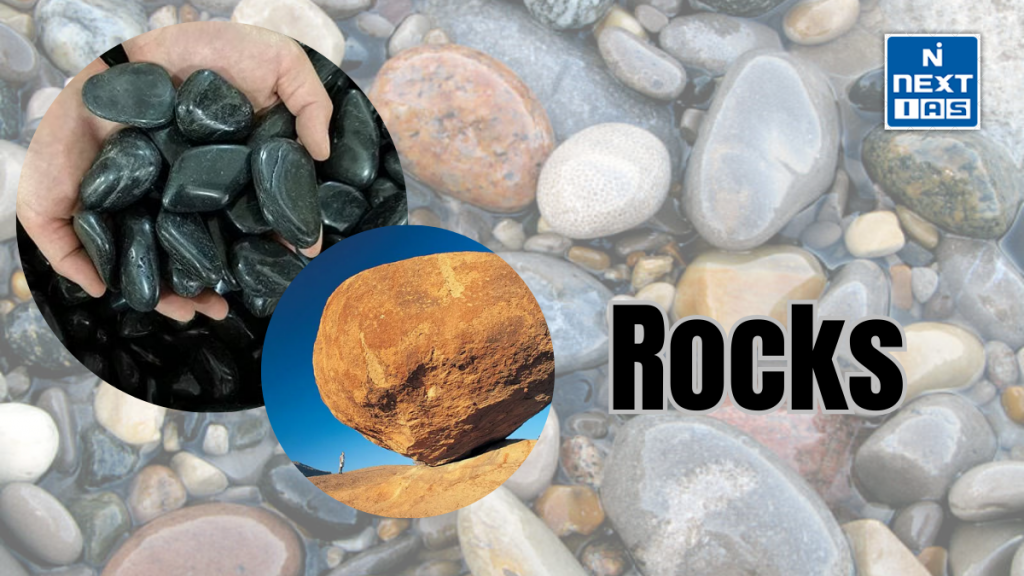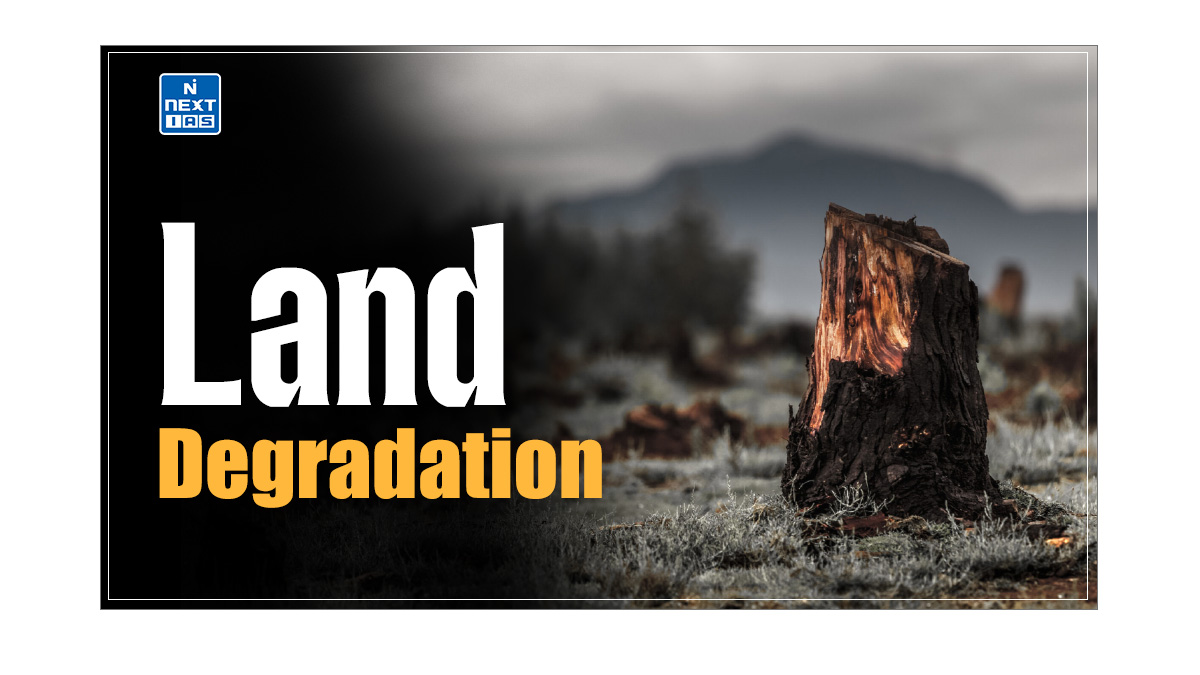
Rocks are solid, naturally formed substances consisting of various minerals and organic matter. They form the crust of the Earth, and are classified into three main types: igneous, sedimentary, and metamorphic. Rocks have immense importance in Earth’s geology as landscape formers and ecosystem conditioners. They are also used in numerous activities by humans.
About The Rocks
- Natural objects constituted of mineral or organic substances or a combination of different materials are regarded as rocks. These rocks serve as the crust of the Earth and play a prime role in carving the geological landscapes. Three types of rocks are distinguished: igneous, sedimentary, and metamorphic.
- Igneous rocks exist after cooling and crystallizing molten material into a solid state; instead of magma within or below the surface, lava is erupted onto the surface. Granite and basalt are typical examples.
- Thus, sedimentary requires one more process and is formed when sediments such as sand, mud, or even organic materials are accumulated and consolidated well enough over time. Limestone and sandstone are examples.
- Metamorphism is interested in describing the process involved in changing rocks with high pressure, temperature, or totally new chemistry. Marble from limestone and slate from shale can be given as examples.
- In geological processes, rocks take part directly; besides providing resources such as minerals and fossil fuels, they also determine the formation of soil. Thus, the study of rocks brings with it a comprehension of the history of Earth and the processes that have been shaping perfect machinery.
Types of Rocks
Rocks are classified into three main categories based on their formation process: igneous, sedimentary, and metamorphic. Each type has distinct characteristics and plays a unique role in Earth’s geology.
Igneous Rocks
- Formation: When molten rock (magma or lava) cools down and solidifies, the rocks so formed are called igneous.
- Characteristics: Depending upon whether the magma cools slowly or fast, the rocks can be coarse-grained or fine-grained, respectively.
- Examples:
- Granite: A coarse-grained rock resulting from the slow cooling of magma deep down underground.
- Basalt: A fine-grained rock produced by rapid cooling of lava at the Earth’s surface.
- Obsidian: A naturally occurring volcanic glass resulting from the rapid cooling of lava.
Sedimentary Rocks
- Formation: Sedimentary rocks are formed from sediments that accumulate, compact, and cement over time. These sediments can include sand, mud, and organic materials.
- Characteristics: Layers or strata are commonly observable; fossils may also be present.
- Examples:
- Limestone: Consisting mainly of calcium carbonate, formed often from the remains of marine organisms.
- Sandstone: Composed of sand-sized mineral particles, usually quartz.
- Shale: Created through the compacting of fine clay particles.
Metamorphic Rocks
- Formation: The formation involves changing other rocks (igneous, sedimentary, or other metamorphic rocks) under pressure, high temperature, or chemically active fluids.
- Characteristics: Often have a foliated or non-foliated texture and may show signs of mineral reorientation or new mineral growth.
- Examples:
- Marble: Formed from the metamorphism of limestone, characterized by its fine grain and ability to polish.
- Slate: Formed from the metamorphism of shale, commonly used for roofing.
- Schist: A foliated rock with large, visible mineral crystals.
Each rock type tells a different story about the Earth’s geological history, and their characteristics influence their use in construction, industry, and art.
Formation Process of Rocks
Rocks are formed through various geological processes, depending on their type. These processes are categorized into three main rock formation types: igneous, sedimentary, and metamorphic.
Formation of Igneous Rocks
- Process: The igneous rocks derive from the cooling down and hardening of molten material-magma or lava, depending on whether the material cools beneath or above the surface of the Earth.
- Subtypes:
- Intrusive (Plutonic): Formation of such rocks occurs when magma solidifies slowly at considerable depths, thereby allowing the growth of large crystals. Examples: granite, diorite.
- Extrusive (Volcanic): Lava cools rapidly on the Earth’s surface to give fine-grained to glassy textures to these rocks. Examples: basalt, pumice, obsidian.
Formation of Sedimentary Rocks
- Process: Sedimentary rocks are those that accumulate, compact, and cement sediments such as sand and clay or organic matter, in effect building cemented layers. These sediments may derive from pre-existing rocks; they may be biologically formed or chemically precipitated.
- Subtypes:
- Clastic Sedimentary Rock: Formed by materials designated as fragments of other rocks (e.g., sandstone and shale).
- Chemical Sedimentary Rock: Result from the evaporation of water or precipitation of minerals (e.g., limestone and rock salt).
- Organic Sedimentary Rock: Result from remains of vegetation and animals (e.g., coal, chalk).
Metamorphic Rock Formation
- Process: Metamorphic rocks are formed when pre-existing rocks (igneous, sedimentary, or other metamorphic rocks) are subjected to high pressure, temperature, or chemically active fluids, causing physical and chemical changes.
- Subtypes:
- Foliated Metamorphic Rocks: These have a layered or banded appearance due to the alignment of minerals under pressure (e.g., schist, slate).
- Non-Foliated Metamorphic Rocks: These lack a layered structure and are often composed of a single mineral or a homogenous texture (e.g., marble, quartzite).
Summary of Processes
- Igneous: Cooling and solidification of molten rock (magma or lava).
- Sedimentary: Accumulation and lithification of sediments.
- Metamorphic: Alteration of existing rocks under high pressure and temperature.
These processes are constantly occurring deep within the Earth, shaping the planet’s surface over geological time scales.
Significance of Rocks
In the geological sphere, stones are important in the processes of the Earth, while they have practical, ecological, and cultural significance. Below are the crucial aspects of their importance:
Formation of Earth’s Crust
- Rocks form the crust of the Earth and are basically responsible for shaping the surface of the planet. Several types of rocks interact to form mountains, valleys, and other geological features.
Natural Resources
- Minerals: Various precious minerals/glittering metals-grow inside rocks, including gold, silver, iron, and copper, alongside non-metallic types like limestone and gypsum.
- Fossil Fuels: Fossil fuels and energy supplies from industries, transport, and homes mainly come from sedimentary rocks, like shale and coal.
- Building Materials: rocks like granite, limestone, and sandstone are widely recognized as traditional building materials for buildings, roads, and monuments.
Soil Formation
- Rocks undergo weathering and break down to form soil, which provides the best medium for plant growth. Soils are very important for agricultural purposes and the sustenance of ecosystems.
Historical and Scientific Records
- The rocks maintain the records of the Earth’s history, including the fossilized remains of plants and animals that were of utmost help to scientists in grasping climate changes or forms of life and geological events in the past.
- Stratigraphy: The different layers of sedimentary rocks assist scientists, providing the history of the Earth including the age of different rock layers.
Environmental Protection
- Certain rocks such as volcanic rocks enrich the soil and are thus vital for the agricultural industry. Therefore, rocks are also important regulators of the carbon cycle on Earth. For example, limestone rocks absorb carbon dioxide, greatly decreasing its concentration in the atmosphere.
Economic Significance
- Industries revolve around rocks in one way or another: construction, manufacturing, and mining. Quarrying and mining activities give us materials for the infrastructure, tools, and machinery.
Aesthetic and Cultural Importance
- Cultural rock types such as marble and sandstone are widely used for art and architecture as sculptural purposes, buildings, and monuments. Landscaping also involves rock placement for aesthetic attractiveness in parks and gardens.
Geothermal Energy
- Certain rocks found in geothermal zones, like basalt, are used for harnessing geothermal energy, a renewable energy source that helps meet global energy demands.
Rocks are fundamental to Earth’s natural processes and human society. They provide valuable resources, contribute to environmental stability, and offer insight into the Earth’s history and development.
Raw Materials Obtained from Rocks
Rocks provide various raw materials needed by different industries. Several geological methods are executed to obtain raw materials through mining and quarrying. Some raw materials thus obtained from different rocks include:
Minerals
- Metallic Minerals:
- Iron Ore: It is obtained from rocks such as hematite and magnetite and is used in making steel.
- Copper: It is found in rocks such as chalcopyrite and is used in electrical wiring, plumbing, and construction.
- Gold: It is extracted from quartz veins and placer deposits and used in jewelry and electronics.
- Silver: It is extracted from ores like argentite and used for jewelry, coins, and electronics.
- Aluminum: It is extracted from bauxite, a sedimentary rock, and the metal is used for manufacturing lightweight materials.
- Non-Metallic Minerals:
- Limestone: It is a sedimentary rock used in cement production, construction, and agriculture.
- Gypsum: Used for manufacturing plaster and drywall.
- Salt: Extracted from evaporated rock salt deposits, used for de-icing and as seasoning.
- Phosphate: Extracted from phosphate rock and mostly used in fertilizers.
Fossil Fuels
- Coal: Sedimentary rocks formed from the remnants of plant materials and exploited to generate power.
- Oil & Gas: Though technically not classed as rocks, these liquids are trapped in porous rocks like sandstone or limestone, for instance, and extracted by drilling for use as fuels, transportation, and in processes of manufacture.
- Shale Oil: It is presumed to be an important growing energy source with oil generated from shale rocks through hydraulic fracturing.
Construction Materials
- Sandstone: Sedimentary rock used for construction purposes, including making bricks and concrete.
- Granite: An igneous rock considered to be one of the most beautiful and durable to be used in countertops, construction, and monuments.
- Marble: A metamorphic rock derived from limestone and used for sculpture, flooring, and decorative surfaces.
- Limestone: Used in construction and for making cement; also used as a building material.
Industrial Minerals
- Clay: Extracted from sedimentary rocks and used in ceramics, bricks, and tiles.
- Talc: A soft mineral found in metamorphic rocks, used in cosmetics, soap, and paper production.
- Asbestos: A group of minerals found in metamorphic rocks, previously used in insulation, roofing, and other construction materials (now heavily regulated due to health risks).
Gemstones
- Diamonds: Found in kimberlite pipes, a type of volcanic rock, diamonds are used in jewelry and for industrial cutting purposes.
- Sapphires, Rubies, and Emeralds: These precious gemstones occur in various igneous and metamorphic rocks and are exploited for jewelry and fancy objects.
Aggregates
- Gravel, Sand, and Crushed Stone: Dating from the weathering and crushing of rocks like granite, limestone, and basalt, these are used in construction for concrete, road building, and various infrastructure projects.
Way Forward
Sustainable extraction practices, better recycling of rock-based materials, and management of natural resources constitute the ways ahead for rocks. Research into rock-related technologies, such as geothermal energy and carbon sequestration, can be promoted to support the environment. Yet, the generation of consciousness for responsible mining and conservation becomes necessary for future generations.
GS - 3




